
A | B | C | D | E | F | G | H | CH | I | J | K | L | M | N | O | P | Q | R | S | T | U | V | W | X | Y | Z | 0 | 1 | 2 | 3 | 4 | 5 | 6 | 7 | 8 | 9
 | |
 Reverse side of a Blu-ray. Unlike CD and DVD, the reflection has a blue hue. Branded colors include silver, gold, and grey. | |
| Media type | High-density optical disc |
|---|---|
| Encoding |
|
| Capacity | |
| Block size | 2 KB sector,[1] 64 KB ECC-block[2] |
| Read mechanism | 405 nm diode laser, 36 Mbit/s |
| Write mechanism | 405 nm diode laser with a focused beam using more power than for reading |
| Developed by | |
| Dimensions | |
| Usage | |
| Extended from | DVD |
| Extended to | |
| Released | June 20, 2006 |
| Optical discs |
|---|
Blu-ray (Blu-ray Disc or BD) is a digital optical disc data storage format designed to supersede the DVD format. It was invented and developed in 2005 and released worldwide on June 20, 2006, capable of storing several hours of high-definition video (HDTV 720p and 1080p). The main application of Blu-ray is as a medium for video material such as feature films and for the physical distribution of video games for the PlayStation 3, PlayStation 4, PlayStation 5, Xbox One, and Xbox Series X. The name refers to the blue laser (actually a violet laser) used to read the disc, which allows information to be stored at a greater density than is possible with the longer-wavelength red laser used for DVDs.
The polycarbonate disc is 12 centimetres (4+3⁄4 inches) in diameter and 1.2 millimetres (1⁄16 inch) thick, the same size as DVDs and CDs.[5] Conventional (or "pre-BD-XL") Blu-ray Discs contain 25 GB per layer, with dual-layer discs (50 GB) being the industry standard for feature-length video discs. Triple-layer discs (100 GB) and quadruple-layer discs (128 GB) are available for BD-XL re-writer drives.[6]
While the DVD-Video specification has a maximum resolution of 480p (NTSC, 720 × 480 pixels) or 576p (PAL, 720 × 576 pixels),[7] the initial Blu-ray specification defined a maximum resolution of 1080p (1920 × 1080 pixels) at up to 24 progressive or 29.97 interlaced frames per second. Revisions to the specification allowed newer Blu-ray players to support videos with a resolution of 1440 × 1080 pixels, with Ultra HD Blu-ray players extending the maximum resolution to 4K (3840 × 2160 pixels) and progressive frame rates up to 60 frames per second. Aside from a 8K resolution (7680 × 4320 pixels) Blu-ray format exclusive to Japan,[8] videos with non-standard resolutions must use letterboxing to conform to a resolution supported by the Blu-ray specification. Besides these hardware specifications, Blu-ray is associated with a set of multimedia formats.
The BD format was developed by the Blu-ray Disc Association, a group representing makers of consumer electronics, computer hardware, and motion pictures. Sony unveiled the first Blu-ray Disc prototypes in October 2000, and the first prototype player was released in Japan in April 2003. Afterward, it continued to be developed until its official worldwide release on June 20, 2006, beginning the high-definition optical disc format war, where Blu-ray Disc competed with the HD DVD format. Toshiba, the main company supporting HD DVD, conceded in February 2008,[9] and later released its own Blu-ray Disc player in late 2009.[10] According to Media Research, high-definition software sales in the United States were slower in the first two years than DVD software sales.[11] Blu-ray's competition includes video on demand (VOD) and DVD.[12] In January 2016, 44% of U.S. broadband households had a Blu-ray player.[13]
History
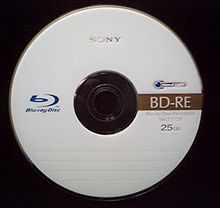

Early history
The information density of the DVD format was limited by the wavelength of the laser diodes used. Following protracted development, blue laser diodes operating at 405 nanometers became available on a production basis, allowing for development of a denser storage format that could hold higher-definition media, with prototype discs made with diodes at a slightly longer wavelength of 407 nanometers in October 1998.[14][15] Sony commenced two projects in collaboration with Panasonic, Philips, and TDK,[16] applying the new diodes: UDO (Ultra Density Optical),[17] and DVR Blue (together with Pioneer),[18] a format of rewritable discs that would eventually become Blu-ray Disc (more specifically, BD-RE). The core technologies of the formats are similar. The first DVR Blue prototypes were unveiled by Sony at the CEATEC exhibition in October 2000.[19] A trademark for the "Blue Disc" logo was filed on February 9, 2001.[20] On February 19, 2002, the project was officially announced as Blu-ray Disc,[21][22] and Blu-ray Disc Founders was founded by the nine initial members.
The first consumer device arrived in stores on April 10, 2003: the Sony BDZ-S77, a US$3,800 BD-RE recorder that was made available only in Japan.[23] However, there was no standard for pre-recorded video, and no movies were released for this player. Hollywood studios insisted that players be equipped with digital rights management before they would release movies for the new format, and they wanted a new DRM system that would be more secure than the failed Content Scramble System (CSS) used on DVDs. On October 4, 2004, the name Blu-ray Disc Founders was officially changed to the Blu-ray Disc Association (BDA), and 20th Century Fox joined the BDA's Board of Directors.[24] The Blu-ray Disc physical specifications were completed in 2004.[25] The recording layer on which the data is stored lies under a 0.1 millimeter protective layer and on top of a 1.1 millimeter substrate made of polycarbonate plastic; Sony also announced in April 2004 a version using paper as the substrate developed with Toppan Printing, with up to 25 GB storage.[26][27]
In January 2005, TDK announced that it had developed an ultra-hard yet very thin polymer coating ("Durabis") for Blu-ray Discs; this was a significant technical advance because a far tougher protection was desired in the consumer market to protect bare discs against scratching and damage compared to DVD, while technically Blu-ray Disc required a much thinner layer for the denser and higher-frequency blue laser.[28] Cartridges, originally used for scratch protection, were no longer necessary and were scrapped. The BD-ROM specifications were finalized in early 2006.[29]
Advanced Access Content System Licensing Administrator (AACS LA), a consortium founded in 2004,[30] had been developing the DRM platform that could be used to securely distribute movies to consumers. However, the final AACS standard was delayed,[31] and then delayed again when an important member of the Blu-ray Disc group voiced concerns.[32] At the request of the initial hardware manufacturers, including Toshiba, Pioneer, and Samsung, an interim standard was published that did not include some features, such as managed copy.[33]
Launch and sales developments
The first BD-ROM players (Samsung BD-P1000) were shipped in mid-June 2006, though HD DVD players beat them to market by a few months.[34][35] The first Blu-ray Disc titles were released on June 20, 2006: 50 First Dates, The Fifth Element, Hitch, House of Flying Daggers, Underworld: Evolution, xXx (all from Sony), and MGM's The Terminator.[36] The earliest releases used MPEG-2 video compression, the same method used on standard DVDs. The first releases using the newer VC-1 and AVC formats were introduced in September 2006.[37] The first movies using 50 GB dual-layer discs were introduced in October 2006.[38] The first audio-only albums were released in May 2008.[39][40]
By June 2008, over 2,500 Blu-ray Disc titles were available in Australia and the United Kingdom, with 3,500 in the United States and Canada.[41] In Japan, over 3,300 titles had been released as of July 2010.[42]
Competition from HD DVD
The DVD Forum, chaired by Toshiba, was split over whether to develop the more expensive blue laser technology. In March 2002 the forum approved a proposal, which was endorsed by Warner Bros. and other motion picture studios. The proposal involved compressing high-definition video onto dual-layer standard DVD-9 discs.[43][44] In spite of this decision, however, the DVD Forum's Steering Committee announced in April that it was pursuing its own blue-laser high-definition video solution. In August, Toshiba and NEC announced their competing standard, the Advanced Optical Disc.[45] It was finally adopted by the DVD Forum and renamed HD DVD the next year,[46] after being voted down twice by DVD Forum members who were also Blu-ray Disc Association members—a situation that drew preliminary investigations by the U.S. Department of Justice.[47]
HD DVD had a head start in the high-definition video market, as Blu-ray Disc sales were slow to gain market share. The first Blu-ray Disc player was perceived as expensive and buggy, and there were few titles available.[48]
The Sony PlayStation 3, which contained a Blu-ray Disc player for primary storage, helped support Blu-ray.[49] Sony also ran a more thorough and influential marketing campaign for the format.[50] AVCHD camcorders were also introduced in 2006. These recordings can be played back on many Blu-ray Disc players without re-encoding but are not compatible with HD DVD players. By January 2007, Blu-ray Discs had outsold HD DVDs,[51] and during the first three quarters of 2007, BD outsold HD DVD by about two to one. At CES 2007, Warner proposed Total Hi Def—a hybrid disc containing Blu-ray on one side and HD DVD on the other, but it was never released.
On June 28, 2007, 20th Century Fox cited Blu-ray Discs' adoption of the BD+ anticopying system as key to their decision to support the Blu-ray Disc format.[52][53]
On January 4, 2008, a day before CES 2008, Warner Bros., the only major studio still releasing movies in both HD DVD and Blu-ray Disc format, announced that it would release only in Blu-ray after May 2008.[54] This effectively included other studios that came under the Warner umbrella, such as New Line Cinema and HBO—though in Europe, HBO's distribution partner, the BBC, announced it would continue to release product on both formats while keeping an eye on market forces. This led to a chain reaction in the industry, with major American retailers such as Best Buy, Walmart, and Circuit City and Canadian chains such as Future Shop dropping HD DVD in their stores. Woolworths, then a major European retailer, dropped HD DVD from its inventory.[55] Major DVD rental companies Netflix and Blockbuster said they would no longer carry HD DVD.
Following these new developments, on February 19, 2008, Toshiba announced it would end production of HD DVD devices,[56] allowing Blu-ray Disc to become the industry standard for high-density optical discs. Universal Studios, the sole major studio to back HD DVD since its inception, said shortly after Toshiba's announcement: "While Universal values the close partnership we have shared with Toshiba, it is time to turn our focus to releasing new and catalog titles on Blu-ray Disc."[57] Paramount Pictures, which started releasing movies only in HD DVD format during late 2007, also said it would start releasing on Blu-ray Disc. Both studios announced initial Blu-ray lineups in May 2008. With this, all major Hollywood studios supported Blu-ray.[58]
Ongoing development
This article needs to be updated. (April 2018) |
2005–2010
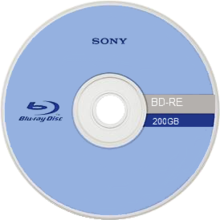
Although the Blu-ray Disc specification has been finalized, engineers continue to work on advancing the technology. By 2005, quad-layer (100 GB)[59] discs had been demonstrated on a drive with modified optics[60] and standard unaltered optics.[61] Hitachi stated that such a disc could be used to store 7 hours of 32 Mbit/s video (HDTV) or 3 hours and 30 minutes of 64 Mbit/s video (ultra-high-definition television). In April 2006, TDK canceled plans to produce 8-layer 200 GB Blu-ray Discs.[62] In August 2006, TDK announced that it had created a working experimental Blu-ray Disc capable of holding 200 GB of data on a single side, using six 33 GB data layers.[63] In 2007, Hitachi was reported to have plans to produce 200 GB discs by 2009.[64]
Behind closed doors at CES 2007, Ritek revealed that it had successfully developed a high-definition optical disc process that extended the disc capacity to ten layers, increasing the capacity of the discs to 250 GB. However, it noted the major obstacle was that current read/write technology did not allow additional layers.[65] JVC developed a three-layer technology that allows putting both standard-definition DVD data and HD data on a BD/(standard) DVD combination.[66] This would have enabled the consumer to purchase a disc that can be played on DVD players and can also reveal its HD version when played on a BD player.[67] Japanese optical disc manufacturer Infinity announced the first "hybrid" Blu-ray Disc/(standard) DVD combo, to be released February 18, 2009. This disc set of the TV series Code Blue featured four hybrid discs containing a single Blu-ray Disc layer (25 GB) and two DVD layers (9 GB) on the same side of the disc.[68]
In January 2007, Hitachi showcased a 100 GB Blu-ray Disc, consisting of four layers containing 25 GB each.[69] It claimed that, unlike TDK's and Panasonic's 100 GB discs, this disc would be readable on standard Blu-ray Disc drives that were currently in circulation, and it was believed that a firmware update was the only requirement to make it readable by then-current players and drives.[70] In October 2007 they revealed a 100 GB Blu-ray Disc drive.[71] In December 2008, Pioneer Corporation unveiled a 400 GB Blu-ray Disc (containing 16 data layers, 25 GB each) compatible with current players after a firmware update. Its planned launch was in the 2009–10 time frame for ROM and 2010–13 for rewritable discs. Ongoing development was underway to create a 1 TB Blu-ray Disc.[72]
At CES 2009, Panasonic unveiled the DMP-B15, the first portable Blu-ray Disc player, and Sharp introduced the LC-BD60U and LC-BD80U series, the first LCD HDTVs with integrated Blu-ray Disc players. Sharp also announced that it would sell HDTVs with integrated Blu-ray Disc recorders in the United States by the end of 2009. Set-top box recorders were not being sold in the U.S. for fear of unauthorized copying. However, personal computers with Blu-ray recorder drives were available. In October 2009, TDK demonstrated a 10-layer 320 GB Blu-ray Disc.[73] On January 1, 2010, Sony, in association with Panasonic, announced plans to increase the storage capacity on their Blu-ray Discs from 25 GB to 33.4 GB via a technology called i-MLSE (maximum likelihood sequence estimation). The higher-capacity discs, according to Sony, would be readable on existing Blu-ray Disc players with a firmware upgrade.[74] This technology was later used on BDXL discs.[75]
On July 20, 2010, the research team of Sony and Japanese Tohoku University announced the joint development of a blue-violet laser,[76] to help create Blu-ray Discs with a capacity of 1 TB using only two layers (and potentially more than 1 TB with additional layering). By comparison, the first blue laser was invented in 1996, with the first prototype discs coming four years later.
2011–present
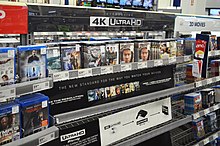
On January 7, 2013, Sony announced that it would release "Mastered in 4K" Blu-ray Disc titles sourced at 4K and encoded at 1080p.[77] "Mastered in 4K" Blu-ray Disc titles can be played on existing Blu-ray Disc players and have a larger color space using xvYCC.[77][78] On January 14, 2013, Blu-ray Disc Association president Andy Parsons stated that a task force was created three months prior to conduct a study concerning an extension to the Blu-ray Disc specification that would add the ability to contain 4K UHD video.[79][80]
On August 5, 2015, the BDA announced it would commence licensing the Ultra HD Blu-ray format starting on August 24, 2015. The Ultra HD Blu-ray format delivered high dynamic range content that significantly expanded the range between the brightest and darkest elements, expanded color range, high frame rate (up to 60fps) and up to 3840 × 2160 resolution, object-based sound formats, and an optional "digital bridge" feature. New players were required to play this format, which were able to play both DVDs, traditional Blu-rays and the new format. New Ultra HD Blu-ray Discs hold up to 66 GB and 100 GB of data on dual- and triple-layer discs, respectively.[81]
Blu-ray's physical and file system specifications are publicly available on the BDA's website.[82]
Future scope and market trends
This article needs to be updated. (April 2018) |
According to Media Research, high-definition software sales in the United States were slower in the first two years than DVD software sales.[11] 16.3 million DVD software units were sold in the first two years (1997–1998) compared to 8.3 million high-definition software units (2006–2007).[11][83] One reason given for this difference was the smaller marketplace (26.5 million HDTVs in 2007 compared to 100 million SDTVs in 1998).[83] Former HD DVD supporter Microsoft did not make a Blu-ray Disc drive for the Xbox 360.[84] The 360's successor Xbox One features a Blu-ray drive, as does the PS4, with both supporting 3D Blu-ray after later firmware updates.[85][86]
Shortly after the "format war" ended, Blu-ray Disc sales began to increase. A study by the NPD Group found that awareness of Blu-ray Disc had reached 60% of households in the United States. Nielsen VideoScan sales numbers showed that for some titles, such as 20th Century Fox's Hitman, up to 14% of total disc sales were from Blu-ray, although the average Blu-ray sales for the first half of the year were only around 5%. In December 2008, the Blu-ray Disc version of Warner Bros.' The Dark Knight sold 600,000 copies on the first day of its launch in the United States, Canada, and the United Kingdom.[87] A week after the launch, The Dark Knight BD had sold over 1.7 million copies worldwide, making it the first Blu-ray Disc title to sell over a million copies in the first week of release.[88]
| Year | Cumulative sales (millions) |
|---|---|
| 2006 | 1.2[89] |
| 2007 | 19.2[89] |
| 2008 | 82.9[89] |
| 2009 | 177.2[89] |
| 2010 | 350[90] |
According to Singulus Technologies AG, Blu-ray was adopted faster than the DVD format was at a similar period in its development. This conclusion was based on the fact that Singulus Technologies received orders for 21 Blu-ray dual-layer replication machines during the first quarter of 2008, while 17 DVD replication machines of this type were made in the same period in 1997.[91] According to GfK Retail and Technology, in the first week of November 2008, sales of Blu-ray recorders surpassed DVD recorders in Japan.[92] According to the Digital Entertainment Group, the number of Blu-ray Disc playback devices (both set-top box and game console) sold in the United States had reached 28.5 million by the end of 2010.[90]
Blu-ray faces competition from video on demand[93] and from new technologies that allow access to movies on any format or device, such as Digital Entertainment Content Ecosystem or Disney's Keychest.[94] Some commentators suggested that renting Blu-ray would play a vital part in keeping the technology affordable while allowing it to move forward.[95] In an effort to increase sales, studios began releasing films in combo packs with Blu-ray Discs and DVDs, as well as digital copies that can be played on computers and mobile devices. Some are released on "flipper" discs with Blu-ray on one side and DVD on the other. Other strategies are to release movies with the special features only on Blu-ray Discs and none on DVDs.
Blu-ray Discs cost no more to produce than DVD discs.[96] However, reading and writing mechanisms are more complicated, making Blu-ray recorders, drives and players more expensive than their DVD counterparts.[97][98][99] Adoption is also limited due to the widespread use of streaming media.[100][101][102][103] Blu-ray Discs are used to distribute PlayStation 3, PlayStation 4, PlayStation 5, Xbox One and Xbox Series X games, and the aforementioned game consoles can play back regular Blu-ray Discs.
In the mid-2010s, the Ultra HD Blu-ray format was released which is an enhanced variant of Blu-ray compatible with the 4K resolution. Ultra HD Blu-ray discs and players became available in the first quarter of 2016, having a storage capacity of up to 100 GB.[104][105]
By December 2017, the specification for an 8K Blu-ray format was also completed. However, this specification was for Japan only so that it could be used by Japanese public broadcasters like NHK to broadcast in 8K resolution for the Tokyo 2020 Olympic Games in Japan.[8]
Beyond Blu-ray
The Holographic Versatile Disc (HVD), described in the ECMA-377 standard, was in development by the Holography System Development (HSD) Forum using a green writing/reading laser (532 nm) and a red positioning/addressing laser (650 nm). It was to offer MPEG-2, MPEG-4 AVC (H.264), HEVC (H.265), and VC-1 encoding, supporting a maximum storage capacity of 6 TB.[106] No systems conforming to the Ecma International HVD standard have been released.[107] The company responsible for HVD went bankrupt in 2010, making any releases unlikely.[108]
Rise of boutique labels
A boutique Blu-ray label or specialty Blu-ray label is a home video distributor that releases films on Blu-ray or 4K Ultra HD Blu-ray format, characterized by a specific or niche target market[109] and collectable features like "limited edition" or "special edition" releases,[110] deluxe slipcases or packaging, and other materials. Examples of boutique Blu-ray labels include the American Genre Film Archive (AGFA),[111] Arrow Films,[109][111] Canadian International Pictures,[112] The Criterion Collection,[109][111][113] Kino Lorber,[111][114] Severin Films,[110][111] Shout! Factory,[109][111] Twilight Time,[109][115] Vinegar Syndrome,[110][111] and the Warner Archive Collection.[111]
Boutique Blu-ray labels, which are popular among collectors and enthusiasts of film and physical media, have been credited as a factor in a "Blu-ray renaissance" dating back to at least 2018, with some consumers choosing to purchase films on physical formats in an age of digital streaming.[110][116] Reasons some consumers prefer Blu-rays to streaming include higher video quality, the tactile nature of owning a film physically, elaborate packaging, bonus features, and the desire to own or watch films that are not available in streaming services' libraries.[116]
Physical media
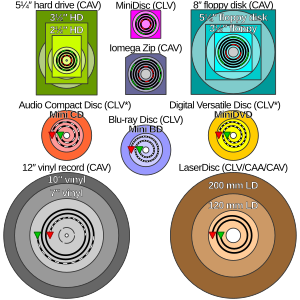
* Some CD-R(W) and DVD-R(W)/DVD+R(W) recorders operate in ZCLV, CAA or CAV modes.
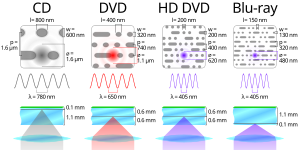
| Type | Diameter (cm) |
Layers | Capacity | |||
|---|---|---|---|---|---|---|
| Bytes | ||||||
| Standard disc size, single layer | 12 | 1 | 25,025,314,816 | |||
| Standard disc size, dual layer | 12 | 2 | 50,050,629,632 | |||
| Standard disc size, XL 3 layer[117] | 12 | 3 | 100,103,356,416 | |||
| Standard disc size, XL 4 layer[117] | 12 | 4 | 128,001,769,472 | |||
| Mini disc size, single layer | 8 | 1 | 7,791,181,824 | |||
| Mini disc size, dual layer | 8 | 2 | 15,582,363,648 | |||
Laser and optics
While a DVD uses a 650 nm red laser, Blu-ray Disc uses a 405 nm "blue" laser diode. Although the laser is called "blue", its color is actually in the violet range. The shorter wavelength can be focused to a smaller area, thus enabling it to read information recorded in pits that are less than half the size of those on a DVD, and can consequently be spaced more closely, resulting in a shorter track pitch, enabling a Blu-ray Disc to hold about five times the amount of information that can be stored on a DVD. The lasers are GaN (gallium nitride) laser diodes that produce 405 nm light directly, that is, without frequency doubling or other nonlinear optical mechanisms.[15][118] CDs use 780 nm near-infrared lasers.
The minimum "spot size" on which a laser can be focused is limited by diffraction and depends on the wavelength of the light and the numerical aperture of the lens used to focus it. By decreasing the wavelength, increasing the numerical aperture from 0.60 to 0.85, and making the cover layer thinner to avoid unwanted optical effects, designers can cause the laser beam to focus on a smaller spot, which effectively allows more information to be stored in the same area.[119] For a Blu-ray Disc, the spot size is 580 nm.[120] This allows a reduction of the pit size from 400 nm for DVD to 150 nm for Blu-ray Disc, and of the track pitch from 740 nm to 320 nm.[119] See compact disc for information on optical discs' physical structure. In addition to the optical improvements, Blu-ray Discs feature improvements in data encoding that further increase the amount of content that can be stored.[121]
Hard-coating technology
Given that the Blu-ray Disc data layer is closer to the surface of the disc compared to the DVD standard, it was found in early designs to be more vulnerable to scratches.[122][123] The first discs were therefore housed in cartridges for protection, resembling Professional Discs introduced by Sony in 2003. Using a cartridge would increase the price of an already expensive medium, and would increase the size of Blu-ray Disc drives, so designers chose hard-coating of the pickup surface instead. TDK was the first company to develop a working scratch-protection coating for Blu-ray Discs, naming it Durabis. In addition, both Sony's and Panasonic's replication methods include proprietary hard-coat technologies. Sony's rewritable media are spin-coated, using a scratch-resistant acrylic and antistatic coating.[124] Verbatim's recordable and rewritable Blu-ray Discs use their own proprietary technology, called Hard Coat.[125] Colloidal silica-dispersed UV-curable resins are used for the hard coating, given that, according to the Blu-ray Disc Association, they offer the best tradeoff between scratch resistance, optical properties, and productivity.[124]
The Blu-ray Disc specification requires the testing of resistance to scratches by mechanical abrasion.[119] In contrast, DVD media are not required to be scratch-resistant, but since development of the technology, some companies, such as Verbatim, implemented hard-coating for more expensive lines of recordable DVDs.
